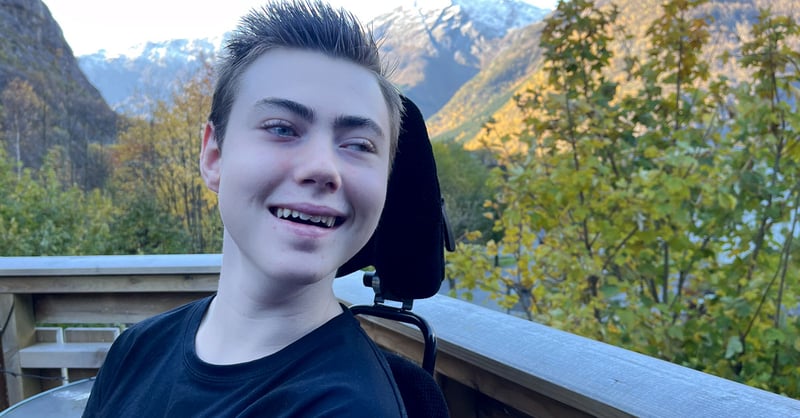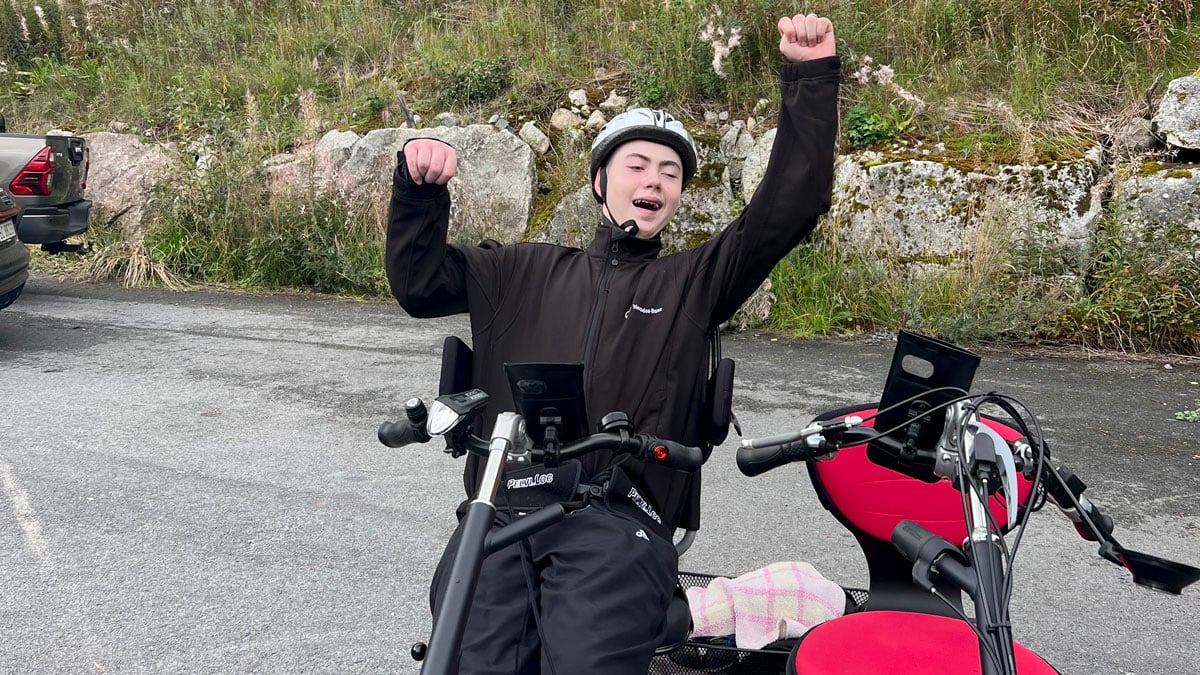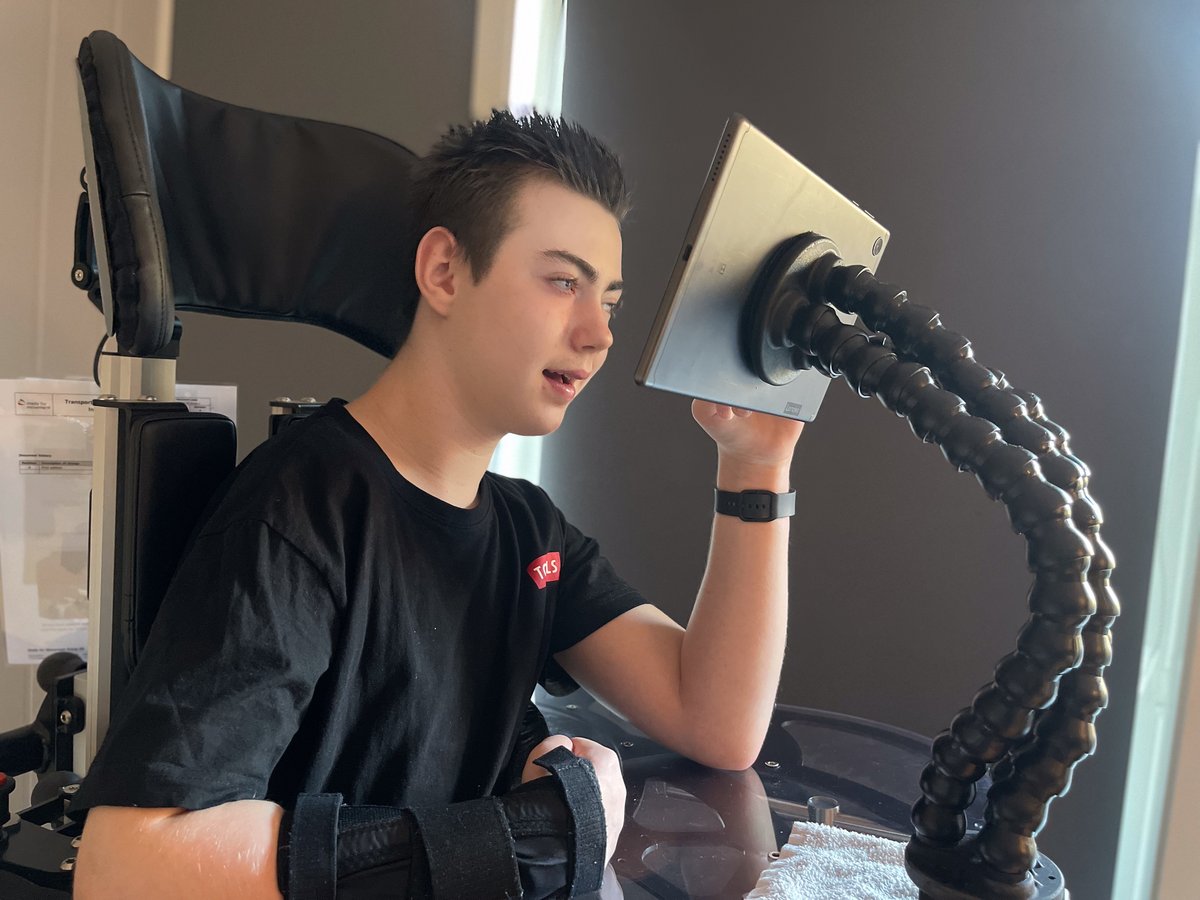[Video] Krister (15) has CP, and he uses the Innowalk every day


Krister has been using the Innowalk for 5 months, and he is already experiencing positive effects on both walking function and joint mobility. The weight-bearing standing activity is motivating and can be done regardless of the season – an important element of maintaining daily activity.
Welcome to Tyssedal!
In Tyssedal, Norway, on a beautiful sunny autumn day in October, I am warmly welcomed into the home of Krister and his family. He lives with his younger sister Anna, and his mother Grethe. They have a magnificent view of the surrounding mountains, and just a couple of kilometers up the road is the starting point for the hike to Trolltunga – a world-known hiking destination. In Tyssedal, there are no straight roads. It’s either uphill or downhill, and the family lives in the middle of a hill. As a wheelchair user, one might think it’s quite a challenge, but not for Krister. He has often driven his electric wheelchair up all the hills, or he takes the bike – luckily, it has an assistive motor.

Krister is an active 15-year-old
Krister is 15 years old and in 10th grade. Like other boys his age, he is into gaming. He really likes Minecraft, racing games and other action games. He plays on both the phone and the iPad. His favorite subject in school is laser printing. The school has acquired a “laser printer”, and Krister, along with a teacher, has started up a student company. He proudly shows off door signs and keychains he has made. At home, you’ll also find a number of plates produced by Krister. They have already delivered signs to both businesses and individuals, and they also have a Facebook page for the business, managed by Krister.
Both Krister and his family are an active bunch, and there is no shortage of leisure activities. Once a week, Krister swims in a hot water pool in Odda, either with his mom or a personal assistant (PA). Two days a week, Krister and his mom do strength training together at the gym. The family also like to go on trips together, and Krister has navigated the sharp turns up to the starting point of Trolltunga in an electric wheelchair. It is both a steep and long journey to the top, but the view was worth it.
Summer brings a lot of traffic past the family’s house, as this is the road to the three parking lots for Trolltunga. This summer Krister decided to record the nationalities visiting Trolltunga, so he and his assistant made daily routes on either a parallel bike or in an electric wheelchair, to the parking lots to record cars and nationalities. Many days he recorded more than 250 cars and up to 7 nationalities. Everything is meticulously recorded with the date, number, and nationalities in a book. A fun activity, and a quick Google search tells us that there are between 80,000-90,000 visitors to Trolltunga each year!
Krister has a CP diagnosis
Krister was born near term but weighed only 2500 grams at birth. He had to come out quickly and he was blue around the nose and mouth right after birth. He had many desaturation episodes in the first few days and struggled to take in nourishment, which led to him spending the first 14 days in the neonatal intensive care unit. The family and Krister were sent home with the understanding that there was a risk of him having CP since he had a tough start to life, and there was a need to closely monitor his development. Around the age of 1, he received the diagnosis of CP, and it was also discovered that he had cataracts. The cause of the cataracts was unknown at the time.
By chance, around the age of 3, Krister was diagnosed with a rare genetic defect that only has a few cases in Norway. The genetic defect causes extremely thin and fragile blood vessels, with a high risk of rapture, especially in the head. The defect also causes the person to develop cataract.
It is not certain, but it’s likely that Krister had a brain hemorrhage either during pregnancy or birth due to the genetic defect, which made him particularly vulnerable to bleeding.
Krister has always been an independent boy and developed steadily. He could sit independently when he was about 1 ½ years old and learned to walk when he was 2 years old. When he started 1st grade, those who didn't know him struggled to understand what he was saying, but he gradually developed his language more and more. Krister laughs when his mom tells him that it seemed like he pronounced all words backwards in the beginning.
Brain hemorrhage in 2021
In February 2021, when Krister was 13 years old, an unexpected incident happened. Krister had a brain hemorrhage. It came completely out of the blue without warning. Krister was placed in an induced coma at Haukeland Hospital in Bergen, Norway. Eventually, Krister woke up. He had lost most functions such as eating, drinking, speaking, sitting, standing, and walking. He couldn't hold his head up and couldn't use his arms, but fortunately, he gradually improved, especially on the left side.
Until June 18, he was at Haukeland, and there was a strong focus on training to regain lost functions. A multidisciplinary team of physiotherapists, occupational therapists, speech therapists, doctors, and nurses were all involved.
"The day we were leaving, the people at the hospital arranged a big party for Krister with balloons, hospital clowns, cakes, and gifts. All the nurses, doctors, physiotherapists, occupational therapists, and speech therapists were present to bid us farewell," says Grethe, Krister's mom.
Functionality today
Hard and regular training since the fatal injury in February 2021 has yielded results. Krister can move between, for example, a chair and toilet/bed when he has something to hold on to, and he can walk short distances with a walker independently. He eats independently, and speech has also partially returned. Krister proudly shows me how he can stand up with the help of support from his mother and the walker and how he can walk from the kitchen to the room. Grethe follows safely behind him and supports him if he loses balance.
Krister has just completed a three-week intensive training block at the Children's Physiotherapy Center in Bergen, Norway.
The goals for the stay were to continue the work on:
- Increasing independence in going from sitting to standing
- Walking short distances with a walker independently
- Going to the bathroom independently, including movement and dressing/undressing
- Undressing a T-shirt and sweater independently
- Floating on the back in the pool independently
The intensive training has helped make Krister even more independent and improve his functions.
Innowalk – Physical Activity Every Day
In November 2022, Krister attended a training program in Beitostølen (Beitostølen is a rehabilitation centre, with extensive focus on physical activity), and that was the first time they were introduced to Innowalk.
"It was the physiotherapist who suggested trying Innowalk because he thought it could be a relevant activity device for Krister. I had never seen the Innowalk before, and when I saw it with Krister in it, I thought: Why hasn't he had this earlier?" says Grethe, Krister's mom.
Beitostølen introduced Innowalk to Krister and arranged a trial at the center. Subsequently, the local physiotherapist applied for the loan of the equipment, and after testing it and it was approved by the national insurance company in Norway, they finally got Innowalk at home. Since May 2023 and up until now (5 months), Krister has been using Innowalk six days a week, between 30-40 minutes each time.
Innowalk has a swiveling seat and foldable leg supports that allow Krister to move independently into the Innowalk. It is either mom Grethe or one of his PAs who assists him. They help him secure all the straps, and soon he is standing. They have attached a Flexzi communication stand to the Innowalk table to mount his iPad at a height that allows him to stand and look straight ahead with his head in a natural position.

Positive Motor Development
"All of Krister's functions have improved since he started using the Innowalk," says Grethe.
Krister's walking with a support walker has improved. He can walk longer distances, and he moves his legs more easily. In the pool, he has always depended on holding onto someone or being supported by a person to walk in the water. Now, he masters short distances without holding on. There is only a need for an adult to walk behind him in case he loses balance.
Krister has recently been evaluated for Botulinum toxin, but based on stable joint goals and even better joint mobility in the ankle joint, treatment was not necessary now. It was highly surprising, and his mother is convinced that Innowalk has contributed to this positive development since it is the only new intervention implemented since the last Botulinum toxin treatment.
Before getting the Innowalk, they practiced daily walking with a walker, but it was demanding and heavy for those assisting Krister, and he struggled to place his legs correctly under him. In Innowalk, he receives a lot of correction, which is impossible to handle manually, while getting many repetitions – around 2000 steps in 30 minutes. Perhaps the many repetitions have contributed to an improved walking function with a support walker?
Active Participation in Innowalk
Krister is 15 years old and enjoys "gaming" while standing in Innowalk. We discuss other types of activities he can do while in Innowalk, such as:
- Actively joining the movement - override the movements in Innowalk by using the muscles actively in the legs
- Interval training – for example, 3 minutes at high speed and 1 minute at a slow pace (repeat)
- Activity with the arms – keeping a balloon in the air while walking in Innowalk
- Biathlon – 5 minutes of walking – STOP walking movement – throwing at the target (repeat
Krister smiles and laughs. He finds it fun to join the movements, and he keeps an eye on the pulse monitor, noticing that the pulse rises when he works actively. This means he gets even more out of the Innowalk session.
They are pleased to have this assistive device, especially now that they enter the winter season. It's more challenging to maintain an active lifestyle when it's cold, wet, and snowy. It's not as easy to get around on a bike, but now Krister can use Innowalk every day regardless of the weather.
We wish Krister the best of luck in the future and look forward to following his development. We thank Krister and Grethe for sharing their story with us, and we hope it serves as inspiration for others.

Rikke Damkjær Moen brings many years of experience as clinical physiotherapist to the Made for Movement team. Her mission is to ensure that everybody, regardless of mobility problems, should be able to experience the joy and health benefits of physical activity. As our Medical Manager, Rikke is passionate about sharing knowledge so that individuals with special needs, families, and clinicians can discover the possibilities and solutions provided by Made for Movement.
The F-words: Fitness, Function, Friends, Family, Fun and Future help practitioners, educators, and families to create a supportive and...
It's a very special story marked by love, effort, and unstoppable determination. It's about Tom and his family. In the interview,...
A severe accident during a hockey game resulted in 35-year-old Tobias breaking his neck and becoming paralysed from the armpits down....
Hear from us from time to time and learn new things
